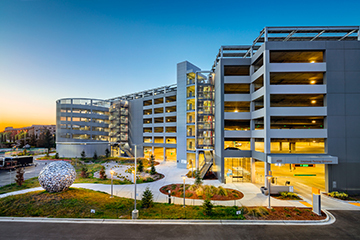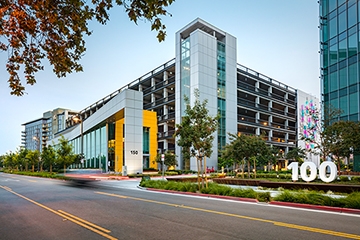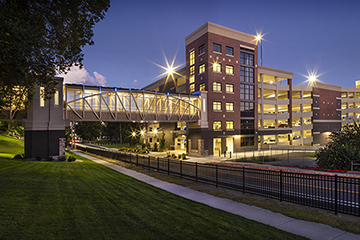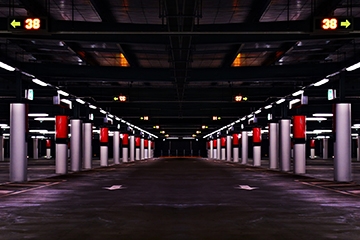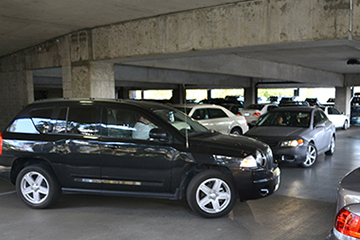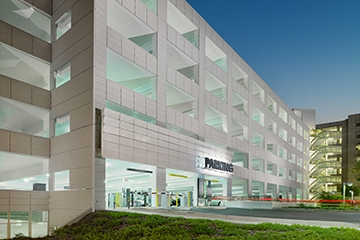Parking in a COVID-19 Reality: Applying Social Distancing, Cleaning Regiments & More for a Safe Arrival Experience
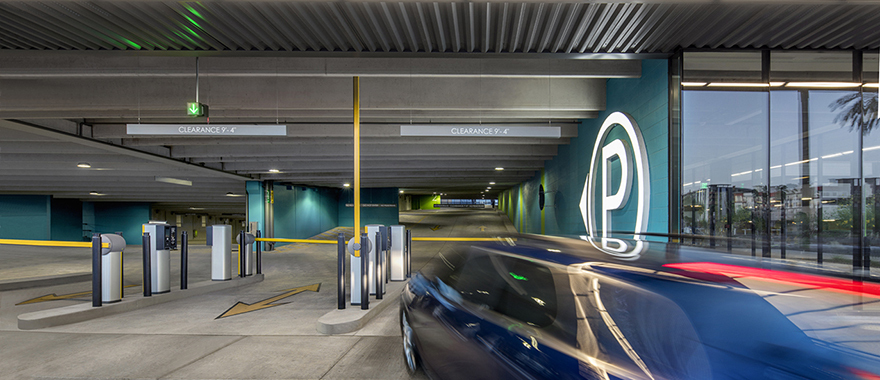
As we plan for a gradual re-opening of the economy, designing an arrival experience for patrons, workers, patients and students that incorporates COVID-19 safety precautions is paramount. For many people, this arrival experience often begins with parking. What should that experience look like?
In addition to the tidal wave of changing information, we must also contend with the emotions that accompany our prolonged and dramatic adjustment to a new normal. People need reassurances that their health and safety is at the top of everyone’s minds, and informing them what measures are being taken to protect them can go a long way towards establishing trust and reducing anxiety. How can parking structure owners and operators assure users that their parking experience has been well thought out?
Start by incorporating the arrival experience into building plans. Think about the flow of various user types. Working with users to understand their needs will help align parking expectations when doors start to re-open. Consider changes in operations such as if employees will now be on site in shifts, if retail operating hours will be altered or start times will be staggered to reduce bottlenecks.
New arrival procedures and what to expect should be included with any other building information being communicated to users, preferably before they ever leave home.
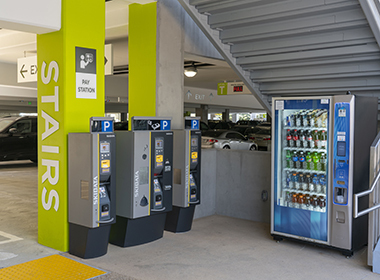 PARCS equipment and other high-contact areas, a regular cleaning schedule should be implemented and communicated to users. - Photo by Tom Paiva
PARCS equipment and other high-contact areas, a regular cleaning schedule should be implemented and communicated to users. - Photo by Tom Paiva
Crafting the Arrival Experience
Whether arriving by bike, public transit, curb side drop off or by car, careful consideration should be made for each way users enter your buildings.
Expanded drop off areas: If ridesharing, family carpooling, etc. is expected, an expanded zone might be needed to provide a safe space for users to be dropped off and picked up. Cones and signage can help define these areas. Extra personnel to monitor and direct traffic can help keep things moving smoothly. Signage should be considered to remind folks to practice social distancing.
Parking Access and Revenue Controls (PARCS): Depending on what type of PARCS system a facility utilizes, this could potentially be a high-contact area. Parking attendants will need to be protected with PPE. Plastic shields can protect both employees and patrons. If PARCS equipment is unmanned, ensure a thorough, regular cleaning schedule is put into place and clearly communicated. Is touchless payment a feature of your equipment? Reach out to your vendor to find out, and let your users know if this is an option they can take advantage of.
Valet: Many returning users may be reluctant to turn their vehicle over to a valet. However, at some parking facilities, valet is required to provide the necessary density to meet parking demand. So how can we protect both valets and users? As with PARCS attendants, PPE supplies should be made available to employees. Covering the steering wheel or even the seat with a temporary paper covering, as you might see at a car mechanic, can also help.
Parking Separation: As mentioned previously, the emotional and psychological effects of COVID-19 are very real and should not be downplayed. While transportation modes such as vehicles and bicycles may not need to social distance, if you have the capacity to provide more space for each car or bike, such as coning off every third stall, you can show your users that you are taking their safety seriously and provide them some peace of mind by making it easier to avoid brushing up against someone else’s vehicle when arriving and departing.
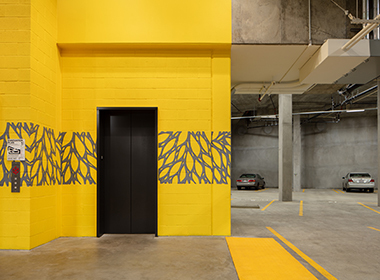 As social distancing is difficult with elevators, you may need to design queuing plan. - Photo by Heather Marie Collins
As social distancing is difficult with elevators, you may need to design queuing plan. - Photo by Heather Marie Collins
Transitioning to Pedestrians
Whether arriving by car, public transit or bike, creating a safe path of travel to get to your destination should be revisited in our new normal. Turning stairwells into one-way paths of travel may be an option, but only if it is still possible to provide the required safe travel distance to the nearest exit. Consider signage, floor decals, screens or even plants to direct pedestrian flows.
If you do not anticipate your facility reaching capacity in the early phases of re-opening, consider directing patrons to park on the lowest levels. Ground floors typically offer more options for entry and exit, which will make it easier to space people out. Additionally, the closer people are to the ground level, the more likely they are to take the stairs rather than create a long queue for an elevator.
Lobbies, elevators, stairwells and other gathering spaces are high contact areas that pose potential risks once drivers transition to pedestrians. Developing a robust cleaning regimen for these areas and posting signage that clearly communicates that plan will help users be and feel safer. Show users that disinfection is taking place by having staff cleaning during business hours. Provide informative signage that outlines the measures being taken to make everyone safer.
You may also need to design a queuing plan for elevators. Social distancing inside an elevator is difficult to impossible; therefore, it may be necessary to restrict usage, which will cause delays. Establishing zones of separation with ground markers will help users maintain safe distance, but be mindful that this does not block the drive aisle and create a safety hazard.
To reduce physical contact with elevator buttons, handrails and doorknobs, consider providing tissue dispensers and trashcans in strategic locations. Elevators can often be re-programmed to travel straight to a destination without stopping on additional floors, which can help enforce social distancing while also improving efficiency, as an elevator will not lose time stopping at an additional floor when it has already reached capacity.
Takeaways
The arrival experience sets the tone for a destination. Therefore, ensuring that the arrival experience is part of re-opening plans can build confidence that an important step in the user journey has been incorporated into their new normal. Creating an intuitive, easy-to-follow flow in and out of the parking facility while reducing points of contact and maintaining adequate separation will go a long way towards achieving that goal.


